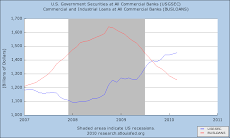 |
| Total quantity of per capita energy used by the US Commercial and Industrial Sectors (excluding transportation). Computed by dividing EIA Energy Consumption by Sector by Total Non-Farm Employment from the Bureau of Labor Statistics.
I love charts ... they're so succinct, and so misleading, at the same time.
Take the one above, for example. Although the chart might be accurate, as far as it goes, it doesn't go far enough. The clue to this fact is in the parenthetical text beneath it, where it admits that the most important energy use, transportation, is not even taken into account.
Now, the point of the article in which this graph appears was to show how as energy inputs increase, labor, by leveraging that increase, can increase its productivity.
What it admits that it doesn't show, is that labor, because it is physically, as well as fiscally, responsible for getting its ass to and from work each and every day, can, when prices of gas are low and consumers therefore opt for larger, more energy-consuming vehicles, change that equation. As asset prices increase, and the work force is forced farther and farther away from the place of employment, the overall energy input is increased. Yet instead of being leveraged to increase productivity, it is leveraged to DEcrease it: more miles are driven, thereby burning more fuel to get a worker to the plant who is already less productive, because driving 2 hours instead of one to get to work is a drain on not only the fuel tank, but on the employee as well, no matter how much they tell themselves otherwise.
However, it's the gallons of fuel burned, ie, that extra energy input, that is the important feature here, because, although more energy has been added to the equation, productivity declines, and although business doesn't have to account for the additional fuel burned to produce the same output, additional fuel is nevertheless burned, and so what gets produced for a given amount of CO2 vented into the atmosphere, which is the ultimate parameter, gets less and less the more fuel prices plummet.
As pointed out in an article in Salon, August was the biggest month ever for U.S. gasoline consumption (well, until September), burning up more than a gallon per day for every
U.S. man, woman and child, as Americans return to their old ways and buy bigger and bigger cars, translating into more weight to haul around one 160 pound load. No matter how many electric vehicles you manufacture, (and the vast majority, not only already on the road, but being scooped off showroom floors, are ICE machines, not electrics/hybrids) the physics of energy usage just don't bend enough to ever make it cost-effective to lug around 3 tons of glass and metal wherever you happen to need to go, but especially not to work. With each ton you add to vehicles' weight you add a requisite increase in energy consumed to move it, and therefore decrease the productivity of the US workforce, all with the necessary collusion of the banking industry, which extends the loans, the insurance companies, which offer ridiculously low insurance premiums, and the government itself, which is responsible for the regulation of both.
|
Which is to say that all the parties that are supposedly working to make the Climate Change agreements hammered out at Copout21 last April are heavily invested in making sure they don't work. And with such an alignment of forces against change working to maintain the status quo, exactly what chances would you give that anything substantial is going to change? That's right. You already know the truth. The agreements will not be met, because it's in nobody's interest, except mankind's, and since each signatory claims to be exempt from obligations to which they hold others, mankind itself, which has no voice in the matter, is doomed.





























No comments:
Post a Comment